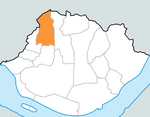Jung District (Korean: 중구; Hanja: 中區; RR: Junggu; lit. Central District) is one of the 25 districts of Seoul, South Korea.
Jung has a population of 131,452 (2013) and has a geographic area 9.96 km2 (3.85 sq mi), making it both the least-populous and the smallest district of Seoul, and is divided into 15 dong (administrative neighborhoods). Jung is located at the centre of Seoul on the northern side of the Han River, bordering the city districts of Jongno to the north, Seodaemun to the northwest, Mapo to the west, Yongsan to the south, Seongdong to the southeast, and Dongdaemun to the northeast.
Jung is the historical city center of Seoul with a variety of old and new, including modern facilities such as high rise office buildings, department stores and shopping malls clustered together, and also a center of tradition where historic sites such as Deoksugung and Namdaemun can be found. Jung is home to cultural sites such as the landmark N Seoul Tower on Namsan Mountain, the Myeongdong Cathedral, the Bank of Korea Museum, and the Gwangtonggwan, the oldest continuously-operating bank building in Korea and one of city's protected monuments since March 5, 2001. The Myeongdong neighborhood is one of the most famous shopping areas and popular tourist destinations in South Korea.
The district has undergone significant redevelopment in the recent decades, especially with the remodeling of Seoul Plaza and the opening up of Cheonggyecheon, previously covered by an elevated highway.









